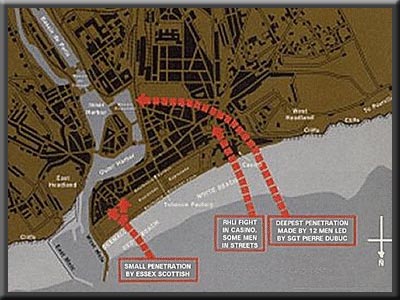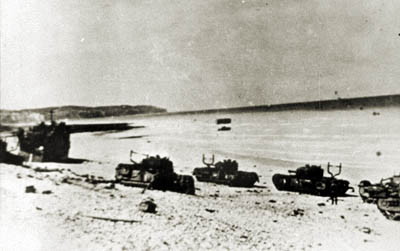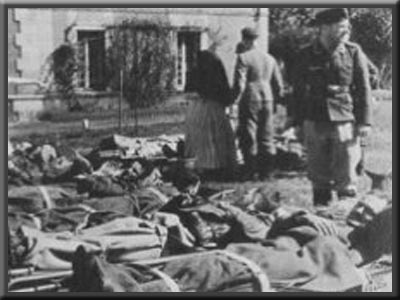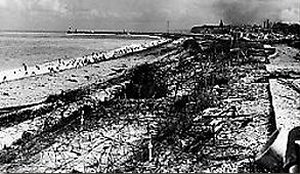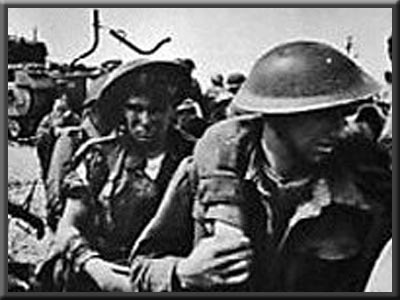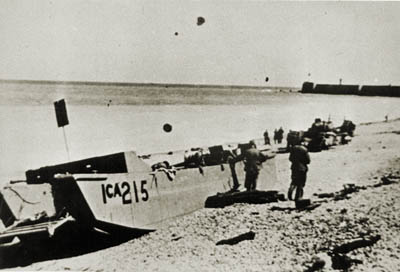
Canada and WW2 - Dieppe
|
Dieppe (Operation Jubilee)
|
|
The Allied situation in the spring of 1942 was grim. The Germans had penetrated deep into Russia, the British Eighth Army in North Africa had been forced back into Egypt, and in Western Europe the Allied forces faced the Germans across the English Channel.
|
| Since the time was not yet ripe for mounting Operation Overlord, the full-scale invasion of Western Europe, the Allies decided to mount a major raid on the French port of Dieppe. Designed to foster German fears of an attack in the west and compel them to strengthen their Channel defences at the expense of other areas of operation, the raid would also provide an opportunity to test new techniques and equipment, and be the means to gain the experience and knowledge necessary for planning the great amphibious assault. |
|
Accordingly, plans were drawn up for a large-scale raid to take place in July 1942. It was called Operation Rutter. Canadians would provide the main assault force, and by May 20 troops of the 2nd Canadian Infantry Division were on the Isle of Wight to begin intensive training in amphibious operations. When unfavourable weather in July prevented Rutter from being launched, it was urged that the idea of a raid should be abandoned. However, the operation was revived and given the new code name Jubilee. The port of Dieppe on the French coast remained the objective.
|
| The attack upon Dieppe took place on August 19, 1942. The troops involved totalled 6,100 of whom roughly 5,000 were Canadians, the remainder being British Commandos and 50 American Rangers. The raid was supported by eight Allied destroyers and 74 Allied air squadrons (eight belonging to the RCAF). Major General J.H. Roberts, the Commander of the 2nd Canadian Division, was appointed Military Force Commander, with Captain J. Hughes-Hallett, R.N. as Naval Force Commander and Air Vice Marshal T.L. Leigh-Mallory as Air Force Commander |
| The plan called for attacks at five different points on a front of roughly 16 kilometres. Four simultaneous flank attacks were to go in just before dawn, followed half an hour later by the main attack on the town of Dieppe itself. Canadians would form the force for the frontal attack on Dieppe and would also go in at gaps in the cliffs at Pourville four kilometres to the west, and at Puys to the east. British commandos were assigned to destroy the coastal batteries at Berneval on the eastern flank, and at Varengeville in the west. |
|
As the assault force approached the coast of France in the early hours of August 19, the landing craft of the eastern sector unexpectedly encountered a small German convoy. The noise of the sharp violent sea fight which followed alerted coastal defences, particularly at Berneval and Puys, leaving little chance of success in this sector. The craft carrying No. 3 Commando were scattered and most of the unit never reached shore. Those who did were quickly overwhelmed. One small party of 20 commandos managed to get within 180 metres of the battery and by accurate sniping prevented the guns from firing on the assault ships for two-and-one-half vital hours before they were safely evacuated.
|
| At Puys the Royal Regiment of Canada shared in the ill-fortune. The beach there was extremely narrow and was commanded by lofty cliffs where German soldiers were strategically placed. Success depended on surprise and darkness, neither of which prevailed. The naval landing was delayed, and as the Royals leapt ashore in the growing light they met violent machine-gun fire from the fully-alerted German soldiers. Only a few men were able to get over the heavily wired seawall at the head of the beach; those who did were unable to get back. The rest of the troops, together with three platoons of reinforcements from the Black Watch (Royal Highland Regiment) of Canada, were pinned on the beach by mortar and machine-gun fire, and were later forced to surrender. Evacuation was impossible in the face of German fire. Of those who landed, 200 were killed and 20 died later of their wounds; the rest were taken prisoner the heaviest toll suffered by a Canadian battalion in a single day throughout the entire war. Failure to clear the eastern headland enabled the Germans to enfilade the Dieppe beaches and nullify the main frontal attack. |
| In the western sector, meanwhile, some degree of surprise was achieved. In contrast to the misfortune encountered by No. 3 on the east flank, the No. 4 Commando operation was completely successful. According to plan, the unit went in, successfully destroyed the guns in the battery near Varengeville, and then withdrew safely. |
|
At Pourville, the Canadians were fortunate enough to achieve some degree of surprise, and initial opposition was light as the South Saskatchewan Regiment and Queen's Own Cameron Highlanders of Canada assaulted the beaches. Resistance stiffened as they crossed the River Scie and pushed towards Dieppe proper. Heavy fighting then developed and the Saskatchewans, and the Camerons who supported them, were stopped well short of the town. The main force of the Camerons, meanwhile, pushed on towards their objective, an inland airfield, and advanced some three kilometres before they too were forced to halt.
|
| The Canadians lost heavily during the withdrawal. The enemy was able to bring fierce fire to bear upon the beach from dominating positions east of Pourville, and also from the high ground to the west. However, the landing craft came in through the storm of fire with self-sacrificing gallantry and, supported by a courageous rearguard, the greater part of both units successfully re-embarked though many of the men were wounded. The rearguard itself could not be brought off and, when ammunition ran out and further evacuation was impossible, surrendered. |
| The main attack was to be made across the pebble beach in front of Dieppe and timed to take place a half-hour later than on the flanks. German soldiers, concealed in clifftop positions and in buildings overlooking the promenade, waited. As the men of the Essex Scottish Regiment assaulted the open eastern section, the enemy swept the beach with machine-gun fire. All attempts to breach the seawall were beaten back with grievous loss. When one small party managed to infiltrate the town, a misleading message was received aboard the headquarters ship which suggested that the Essex Scottish were making headway. Thus, the reserve battalion Les Fusiliers Mont Royal was sent in. They, like their comrades who had landed earlier, found themselves pinned down on the beach and exposed to intense enemy fire. |
| The Royal Hamilton Light Infantry landed at the west end of the promenade opposite a large isolated casino. They were able to clear this strongly-held building and the nearby pillboxes and some men of the battalion got across the bullet-swept boulevard and into the town, where they were engaged in vicious street fighting. |
| Misfortune also attended the landing of the tanks of the Calgary Regiment. Timed to follow an air and naval bombardment, they were put ashore ten to fifteen minutes late, thus leaving the infantry without support during the first critical minutes of the attack. Then as the tanks came ashore, they met an inferno of fire and were brought to a halt stopped not only by enemy guns, but also immobilized by the shingle banks and seawall. Those that negotiated the seawall found their way blocked by concrete obstacles which sealed off the narrow streets. Nevertheless, the immobilized tanks continued to fight, supporting the infantry and contributing greatly to the withdrawal of many of them; the tank crews became prisoners or died in battle. |
|
The last troops to land were part of the Royal Marine "A" Commando, which shared the terrible fate of the Canadians. They suffered heavy losses without being able to accomplish their mission.
|
| The raid also produced a tremendous air battle. While the Allied air forces were able to provide protection from the Luftwaffe for the ships off Dieppe, the cost was high. The Royal Air Force lost 106 aircraft which was to be the highest single-day total of the war. The RCAF loss was 13 aircraft. |
| By early afternoon, Operation Jubilee was over. Conflicting assessments of the value of the raid continue to be presented. Some claim that it was a useless slaughter; others maintain that it was necessary to the successful invasion of the continent two years later on D-Day. The Dieppe Raid was closely studied by those responsible for planning future operations against the enemy-held coast of France. Out of it came improvements in technique, fire support and tactics which reduced D-Day casualties to an unexpected minimum. The men who perished at Dieppe were instrumental in saving countless lives on the 6th of June, 1944. While there can be no doubt that valuable lessons were learned, a frightful price was paid in those morning hours of August 19, 1942. Of the 4,963 Canadians who embarked for the operation only 2,210 returned to England, and many of these were wounded. There were 3,367 casualties, including 1,946 prisoners of war; 907 Canadians lost their lives. |
| Dieppe remains arguably the most controversial Canadian Military History topic; specifically the decision to go ahead with the raid. Well it is easy to make this argument in hindsight; a student of history must consider the factors surrounding the raid at the time, namely the pressures from government and military factors. In the end I think Canadians should recognize the value of Dieppe, as opposed to the tragedy of it. It is tragic that those men died seemingly in vain on that beach in August of 1942. But they saved thousands and thousands of lives on June 6th 1944 and should be remembered for that. |
Published on: 2004-08-05 (28210 reads)
Recent Reviews
- War Horse 2012-01-02
- Legion 2010-01-23
- Zombieland 2009-10-02
- The Martyr's Oath: The Apprenticeship of a Homegrown Terrorist 2009-08-20
- Bachman Cummings 2009-06-22
- Star Trek 2009-05-03
- X-Me Origins: Wolverine 2009-05-01
- Soloist 2009-04-24


